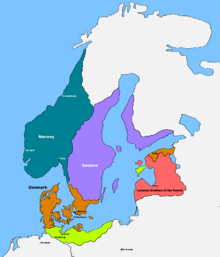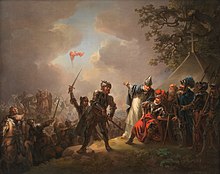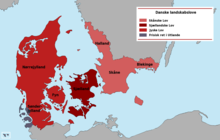Valdemar II of Denmark
This article includes a list of general references, but it lacks sufficient corresponding inline citations. (February 2022) |
| Valdemar II | |||||
|---|---|---|---|---|---|
Berengária of Portugal | |||||
| Issue among others... |
| ||||
| |||||
Estridsen | |||||
| Father | Valdemar I of Denmark | ||||
| Mother | Sophia of Minsk | ||||
Valdemar II Valdemarsen (28 June 1170 – 28 March 1241), later remembered as Valdemar the Victorious (
In 1207, Valdemar invaded and conquered
Background

He was the second son of King
Duke Valdemar realized the threat Bishop Valdemar represented. He thus invited him to Aabenraa in 1192. The bishop then fled to Norway to avoid arrest. The following year, Bishop Valdemar organised – supported by the Hohenstaufens – a fleet of 35 ships and harried the coasts of Denmark, claiming the Danish throne for himself based on the fact that he was the son of King Canute V. In 1193, King Canute VI captured him. Bishop Valdemar stayed in captivity in Nordborg (1193–1198) and then in the tower at Søborg Castle on Zealand until 1206. He was later released upon the initiative of Dagmar of Bohemia (the wife of Duke Valdemar) and Pope Innocent III, after swearing to never interfere again in Danish affairs.[2]

Young Valdemar faced another threat from Count
Reign

Duke Valdemar was subsequently proclaimed king at the Jutland Assembly (landsting). The nearby
In 1203 Valdemar invaded and conquered

In 1207, a majority of Bremian capitulars again elected Bishop Valdemar as prince-archbishop, while a minority, led by the capitular provost Burkhard, Count of Stumpenhausen fled for Hamburg, being the seat of a Bremian subchapter with regional competence and delegating for episcopal elections two participants to the main Bremian chapter. The German King Philip recognised Valdemar as the legitimate prince-archbishop of Bremen, because thus the prince-archbishopric would become his ally against Valdemar II.
Valdemar II and the fled capitulars protested to
In the same year Valdemar II invaded with Danish troops the prince-archiepiscopal territory south of the
In 1210, Innocent III made Gerhard I, Count of Oldenburg-Wildeshausen Bremen's new Prince-Archbishop. In 1211 Duke Bernard III of the younger Duchy of Saxony escorted his brother-in-law Valdemar, the papally dismissed Prince-Archbishop, into the city of Bremen, de facto regaining the See and enjoying the sudden support of Otto IV, who meanwhile fell out with Innocent over Sicily. As a reaction Valdemar II recaptured Stade, while in 1213 Henry V, Count Palatine of the Rhine, conquered it for Prince-Archbishop Valdemar.
In 1213 Valdemar instituted a war tax in Norway, and the peasants murdered Valdemar's tax collector at the Trøndelag Assembly and revolted. The uprising spread over several regions in Norway.
In 1216, Valdemar II and his Danish troops ravaged the County of
.Battle of Lindanise

Christian August Lorentzen
(1809)
The
When the army landed in

During the Battle of Lindanise, the legend says that whenever Bishop Sunesen raised his arms the Danes surged forward and when his arms grew tired and he let them fall the Estonians turned the Danes back. Attendants rushed forward to raise his arms once again and the Danes surged forward again. At the height of the battle Bishop Sunsen prayed for a sign and it came in the form of a red cloth with a white cross which drifted down from the sky just as the Danes began to fall back. A voice was heard to say "When this banner is raised on high, you shall be victorious!"[3] The Danes surged forward and won the battle. At the end of the day thousands of Estonians lay dead on the field, and Estonia was added to the Danish realm. Estonians were forcibly baptised as Christians, but according to an in depth study of the Liber Census Daniæ by the historian Edgar Sachs, the Estonians quite voluntarily converted to the Christian faith.
Valdemar ordered the construction of a great fortress at
Battle of Bornhöved
In 1223, King Valdemar and his eldest son, prince
Valdemar immediately appealed to Pope
Code of Jutland

From that time on, King Valdemar II focused his efforts on domestic affairs. One of the changes he instituted was the feudal system, where he gave properties to men with the understanding that they owed him service in return. This increased the power of the noble families (højadelen) and gave rise to the lesser nobles (lavadelen'), who controlled most of Denmark. Free peasants lost the traditional rights and privileges they had enjoyed since the Viking era.[6]
King Valdemar II spent the remainder of his life putting together a code of laws for
Marriages
Before his first marriage, Valdemar had been betrothed to Rixa of
After Margaret's death, in order to build good relations with
Issue
With his first wife, Dagmar of Bohemia, whom he wed in 1205, Valdamar had the following children:
- Valdemar the Young of Denmark (1209 – 28 November 1231), married Eleanor of Portugal.
- Stillborn son (1212)
With his second wife, Berengaria of Portugal, whom he wed in 1214,[7] he had the following children:
- Eric IV, King of Denmark (1216 – 10 August 1250)[8]
- Sophie of Denmark (1217–1247), married in 1230 to John I, Margrave of Brandenburg[8]
- Abel, King of Denmark (1218 – 29 June 1252)[8]
- Christopher I, King of Denmark (1219 – 29 May 1259)[8]
- Stillborn child (1221)
In memoriam
Valdemar enjoys a central position in Danish history because of his position as "the king of Dannebrog" and as a legislator. To posterity, the civil wars and dissolution that followed his death made him appear to be the last king of a golden age. Since 1912, June 15 has officially been called Valdemarsdag (Valdemar's Day). The date now belongs to the group of 33 Danish annual Flag Days where Dannebrog is raised in celebration.[citation needed]
The 1997 film Eye of the Eagle was about a fictional story about Valdemar the Young. His father Valdemar was played by Lars Lohmann.
The Estonian capital Tallinn has a park at Toompea called the Danish King's Garden where the Danish flag Dannebrog was born according to prevailing legends. Every year on 15 June, the Day of the Danish Flag is celebrated in the garden.[9]
References
- ISBN 978-3-529-02606-5
- Dansk biografisk leksikon, vol. XVIII: Ubbe – Wimpffen, pp. 193–197, here p. 195.
- ^ Olsen, Peder. Slaget ved Lyndanise
- ^ Huitfeldt, Arild. Danmarks Riges Krønike
- ^ a b c d Petersen 2010, p. 160.
- ^ Danmark Historie IIperbenny.dk
- ^ Hundahl 2014, p. 270.
- ^ a b c d Line 2007, p. 581.
- ^ "Danish King's Garden, Estonia".
Sources
- Line, Philip (2007). Kingship and State Formation in Sweden: 1130 – 1290. Brill.
- Hundahl, Kerstin (2014). "Placing Blame and Creating Legitimacy: The Implications of Rugish Involvement in the Struggle over the Succession amidst the Danish Church Strife c.1258–1260". In Hundahl, Kerstin; Kjær, Lars; Lund, Niels (eds.). Denmark and Europe in the Middle Ages, c.1000–1525: Essays in Honour of Professor Michael H. Gelting. Ashgate Publishing.
- Petersen, Leif Inge Ree (2010). "Battle of Bornhöved". In Rogers, Clifford J. (ed.). The Oxford Encyclopedia of Medieval Warfare and Military Technology. Vol. 1. Oxford University Press.
External links
 Media related to Valdemar II of Denmark at Wikimedia Commons
Media related to Valdemar II of Denmark at Wikimedia Commons- Bain, Robert Nisbet (1911). . Encyclopædia Britannica. Vol. 27 (11th ed.). pp. 841–842.
- [1][2] Valdemar II garden in Tallinn, Estonia
- http://www.kingsofdenmark.dk/king21.htm

